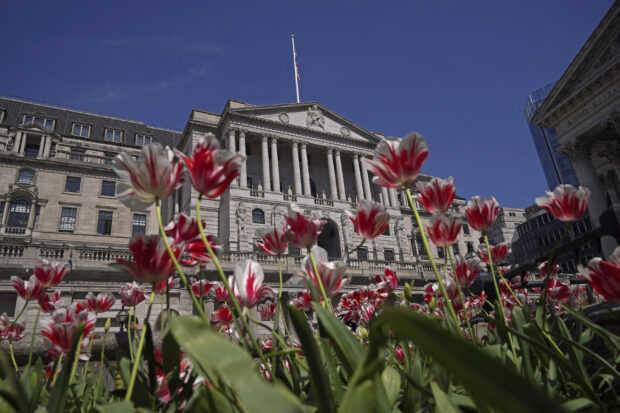
A general view of the Bank of England in London, Thursday May 9, 2024. The Bank of England has kept its main U.K. interest rate at a 16-year high of 5.25% with several policymakers still worrying about some key inflation measures. In a statement Thursday, the bank’s nine-member Monetary Policy Committee voted 7-2 to keep rates unchanged, with the 2 dissenters backing a quarter-point reduction. (Yui Mok/PA via AP)
LONDON — The Bank of England maintained its key U.K. interest rate at a 16-year high of 5.25 percent though it gave a broad hint that a reduction could be on the cards as soon as June as inflation is forecast to fall below target.
In a statement Thursday, the bank’s nine-member Monetary Policy Committee voted 7-2 to keep rates unchanged, with the 2 dissenters backing a quarter-point reduction. Last time, only one member voted for a quarter-point cut.
Like the U.S. Federal Reserve last week, which also kept rates on hold, the majority of the panel wanted to see more evidence that inflation is under control.
The increase in the number of those backing a U.K. rate reduction is a clear indication that there is a shifting balance on the committee in favor of cuts.
READ: Bank of England set to hold rate at 16-year high
“We’ve had encouraging news on inflation and we think it will fall close to our 2 percent target in the next couple of months,” said Bank Governor Andrew Bailey. “We need to see more evidence that inflation will stay low before we can cut interest rates. I’m optimistic that things are moving in the right direction.”
Bailey indicated that the financial markets are more pessimistic about the path of interest rates and that “it is likely that we’ll need to cut bank rates in the coming quarters, possibly more so than is currently priced into markets.”
‘Not a fait accompli’
However, he said a cut at the next meeting in June has “not been ruled out” but insisted that it was “not a fait accompli.”
Headline inflation in the U.K. is down at an annual rate of 3.2 percent, its lowest level in two and a half years, but remains higher than the bank’s 2 percent target.
In forecasts accompanying its decision, the Bank of England said it expects inflation to fall below the target between April and June, but rise again to 2.6 percent in the second half of this year as the impact of recent drops in energy prices fades.
READ: UK inflation falls to lowest level since late 2021 as food prices ease
Longer-term, it said it expects inflation to fall more than previously thought over the coming years to 1.5 percent in 2026. Given that it sets policy to target inflation months and years ahead, that’s a further hint that rates will be cut soon.
That was the view in financial markets, where the British pound fell against other currencies. It was down 0.4% against the dollar, for example, at $1.2450 in the immediate aftermath of the decision as traders priced in the prospect of lower returns on holding pounds.
The Bank of England, like the U.S. Fed and other central banks around the world, raised interest rates aggressively in late 2021 from near zero to counter price rises first stoked by supply chain issues during the coronavirus pandemic and then by Russia’s invasion of Ukraine.
High rates weigh on British economy
Higher interest rates — which cool the economy by making it more expensive to borrow — have helped ease inflation, but they’ve also weighed on the British economy, which is barely growing.
“The decision to keep interest rates on hold, while expected, is a missed opportunity to provide much-needed relief for those people struggling with their mortgage bills and businesses facing numerous cost pressures,” said Suren Thiru, economics director at the Institute of Chartered Accountants in England and Wales.
Lawmakers in the U.K.’s governing Conservative Party, which appears headed for a big electoral defeat later this year to the Labor Party, are hoping the independent Bank of England starts cutting soon, relieving the pressure on financially stretched households, thereby helping to fuel an economic feelgood factor.
“What we want is sustainably low interest rates, and I think what’s encouraging is that the Bank of England governor, for the first time, has expressed real optimism that we’re on that path,” said Treasury chief Jeremy Hunt.